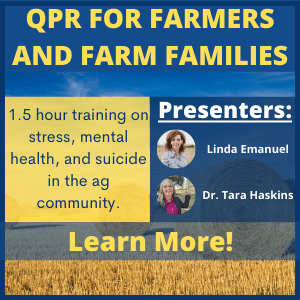Last updated on April 9th, 2024 at 05:56 pm
Respiratory Health Resources
Most of us take for granted that our lungs are going to do their job. We can get out of bed in the morning and take those first deep breaths without thinking. But it really is a gift. Protecting your lungs from farm work-related exposures is essential to your long-term health and your ability to keep doing the work you love.
Once you recognize the hazards, your next step is to either modify the job to remove the hazards or to wear the correct personal protective equipment. Identify locations where you might breathe in grain dust or be exposed to aerosol in a confined space. Aerosol is the term for solid particles or liquid droplets in the air; aerosol might look invisible or like a gas, mist, or fog.
Since many farm jobs require contact with respiratory hazards, personal protective equipment is the remaining option.
When choosing respiratory protection, there are two main points to remember:
- Make sure the respirator or face mask is NIOSH approved.
- Make sure respiratory protection matches the hazard/ is correct for the job.
For more guidance on selecting the right equipment, check out the following:
Text Equivalent of the AgriSafe Decision Guide Chart
Text Equivalent of AgriSafe Rainbow Guide
Respiratory Health Resources
Resource Library
| ID | Title | Summary | Link |
|---|---|---|---|
| 7236 | Agricultural Respirator Selection Guide | A guide on selecting the right respirator for the right job. | |
| 9879 | Agricultural Respiratory Selection Booklet | This guide is designed to assist trained Agricultural Health Professionals to recommend appropriate respirators based on the clients’ agricultural exposure. (This guide is not intended for the professional who has not received training in respirator selection.) | |
| 7235 | Avian Influenza: Personal Protective Equipment (PPE) Guidelines | The information provided in this guide is intended as general guidelines for exposures to Avian Influenza. | |
| 10344 | Can the Bandana….Use an N95! | Check out AgriSafe Community Health Nurse Linda Emanuel and her presentation “Can the Bandana….Use an N95”. | |
| 8705 | Diferencia Entre La Prueba De Ajuste Y La Comprobación Del Sello Del Usuario | The purpose of this Spanish language guide is to help individuals better understand the difference between a Fit Test and a User Seal Check. | |
| 9867 | Gas Monitors for Agriculture | Guidelines to identify hazards and select sensor types based on potential hazards in your farming operation. | |
| 11425 | Guía Para La Selección De Respirador Agrícola | A guide on selecting the right respirator for the right job. | |
| 9865 | How to Comply with the 2015 Revised Worker Protection Standard for Agricultural Pesticides: What Owners and Employers Need to Know | EPA in conjunction with the Pesticide Educational Resources Collaborative (PERC) is making available a guide to help users of agricultural pesticides comply with the requirements of the 2015 revised federal Worker Protection Standard. You should read this manual if you employ agricultural workers or handlers, are involved in the production of agricultural plants as an owner/manager of an agricultural establishment or a commercial (for-hire) pesticide handling establishment, or work as a crop advisor. | |
| 7989 | Knowing the Difference: Fit Test vs User Seal Check | The purpose of this guide is to help individuals better understand the difference between a Fit Test and a User Seal Check. | |
| 9881 | Manure Storage Pit Dangers | Guidance on manure pit operations from ASABE specify the need to monitor these spaces prior to entry. This alert provides general guidance on why and how to monitor. | |
| 8000 | Personal Protective Equipment: OSHA Guidance | This OSHA publication provides a general overview of personal protective equipment requirements and selection. | |
| 10352 | Respiratory Health | episode of Talking Total Farmer Health | |
| 7995 | What to Know About Bird Flu | A guide on what to look for during an avian influenza outbreak. | |
| 9866 | Worker Protection Standards for Agricultural Establishments | This document describes the federal Worker Protection Standards for agricultural establishments. |
Webinars
| Webinar Title | Summary | Link |
|---|---|---|
| Anhydrous Ammonia Safety for Farmworkers (February 24, 2022) | Anhydrous ammonia (NH3) is an effective nitrogen crop fertilizer used throughout the Midwest and beyond. Anhydrous ammonia is potentially dangerous, as it seeks water from the nearest source, which may be the human body – especially the eyes, lungs, and skin because of their high moisture content. Few problems occur when anhydrous ammonia is handled properly and applied as intended. However, it is important for all individuals working with this type of fertilizer to understand the potential health risks, necessary safety precautions, and proper response in the event of an exposure. Focus of the training is on anhydrous ammonia safety during transport and application, including the anatomy of the nurse tank and toolbar, safety inspection processes, hitching and unhitching safety, personal protective equipment (PPE), rural roadway safety, and first aid/emergency procedures. Hazard communication and emergency action plans will also be addressed. | |
| Confined Space – Grain Bin Entry | The Confined Space Grain Safety program is intended for workers and managers in agriculture. This includes Coop’s, farm operators, employees, and agriculture business owners. The major focus of the program is on safety in confined space work areas. | |
| Respiratory Protection Issues in Agriculture – What to Wear & Does It Fit? | The business of agriculture presents a myriad of hazards, including exposures to dusts, molds, pesticides and other chemicals, gases, as well as welding fumes and particles. Deciding what protection to use to prevent acute and chronic respiratory diseases is confusing. In addition, just finding the right protective gear can be a challenge. This webinar will address those issues and provide information on the importance of fit testing and fit (seal) checks. | |
| Respiratory Protection Program Adapted to Grain Handling Operations | The OSHA respiratory standard requires a written respiratory protection program for situations in which permissible exposure levels (PELs) of airborne contaminants could be exceeded or when the employer requires use of respirators by workers. This training will assist agriculture-based employers who require respirator use to comply with the OSHA respiratory protection program standard. Training includes written worksite specific procedures, program evaluation, selection of an appropriate respirator approved by the National Institute for Occupational Safety and Health (NIOSH), training, fit testing, inspection, cleaning, maintenance, and storage, medical evaluation, work area surveillance and air quality standards. |
Page updated: July 2021




